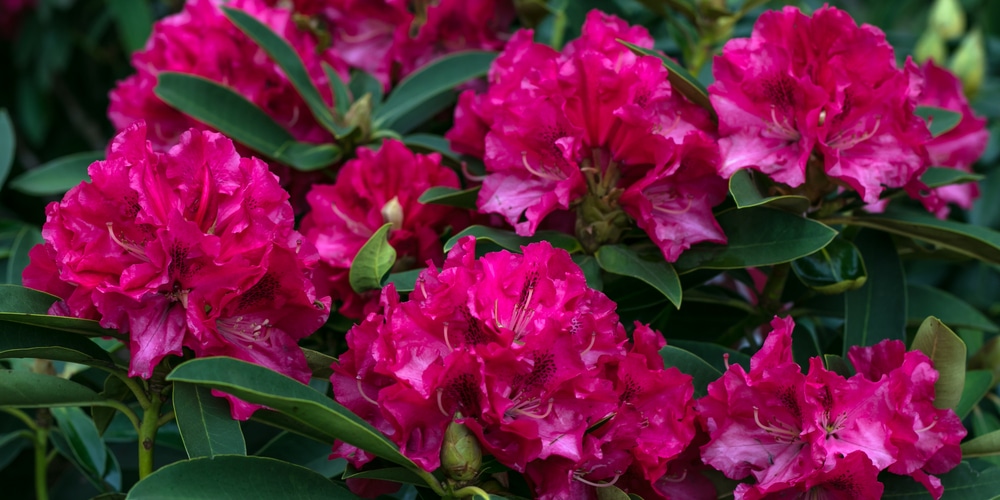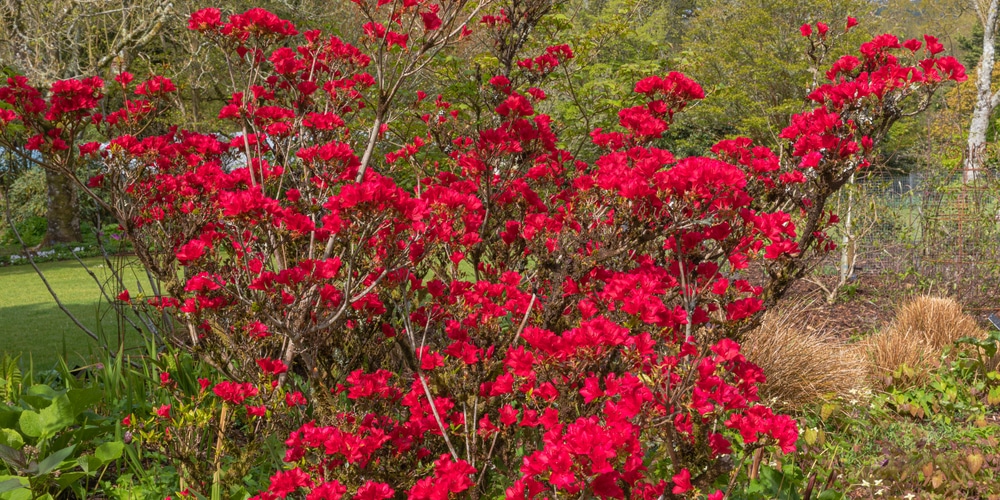When the leaves begin to change color, and the air turns crisp, it signals the arrival of fall. For many gardeners, this is the most exciting time of year. The cool weather brings a welcome respite from the heat of summer, and the colorful foliage is a stunning sight to behold.
One of the best ways to enjoy the fall season is to plant an Autumn Ruby Azalea. These charming plants are covered in rich ruby-red blooms.
| Botanical Name | Rhododendron ‘Conler’ PP12110 |
| Common Name | Autumn Ruby Azalea |
| Plant Type | Perennial |
| Flower Color | Red |
| Size When Mature | 36 inches |
| Bloom Time | Early Spring to Fall |
| Sun Requirements | Partial Sun |
| USDA Hardiness Zones | 6-10 |
| Soil PH Range | 5.5-6.5 |
| Soil Type | Acidic, Neutral, Well-draining |
| Water Needs | Low-Medium |
| Native Area | Asia |
What You Need to Know About Autumn Ruby Azalea
The Autumn Ruby Azalea is a deciduous shrub and is native to Asia. The plant grows to be about 36 inches tall.
The plant’s leaves are one of its most striking features. They are a deep, rich green, with a glossy sheen that seems to shimmer in the sunlight. They take on a beautiful crimson hue in the fall, providing a stunning contrast to the evergreen needles. The leaves are also relatively large, making them perfect for creating bold statements in the landscape.
Spectacular flowers bloom from the plant. They are intensely crimson, with a deep hue that is almost electric. They bloom in profusion in the spring, covering the plant with a blanket of color. The flowers are also quite large, making them stand out even more. In addition, the blooms have a wonderful fragrance that is sure to please any nose.
Avoid having pets around this plant as it is poisonous to them. The leaves and flowers of the plant are toxic if ingested and can cause vomiting, diarrhea, and even death.
Excluding the fact that the plant is toxic, the plant is easy to maintain. It is drought tolerant and does not require that much water.
How to Care for Autumn Ruby Azalea
Here’s everything you need to know about growing and caring for a thriving Autumn Ruby Azalea:
Light
The plant prefers partial shade, so you should plant it in an area that receives filtered sunlight. If exposed to too much direct sun, their leaves will scorch, and their flowers will fade. During the Fall months, when the sun is lower in the sky, it is especially important to protect them from the afternoon sun.
Water and Soil Needs
The most important thing to remember when caring for the plant is to water it regularly. Watering the plant at least once a week during summer. However, in the winter, the amount of water will need to be reduced to about once every two weeks.
In addition, it is essential to ensure that the soil around the plant is always moist. This can be achieved by mulching the plant with organic material such as bark or straw.
Another thing to remember when caring for an Autumn Ruby Azalea is the type of soil it requires. The plant prefers well-drained, acidic soil that is rich in organic matter. If your soil does not meet these requirements, it is vital to amend it before planting the plant. Otherwise, it may become susceptible to root rot and other problems.
Having soil with a pH range of 5.5-6.5 will be best for the plant.
Temperature Requirements
The plant requires specific temperature requirements to thrive and is hardy in USDA zones 6-10. Ideally, the plant should be kept in an area where the temperature ranges from -10°F to 40°F. Dropping below -10°F and the plant leaves will start to turn brown and fall off.
Fertilizer
The best fertilizer to use on an Autumn Ruby Azalea is a slow-release fertilizer with high Nitrogen and Phosphorus. Having a fertilizer with a high content of those two nutrients will ensure that the plant will have lush leaves and bloom beautiful flowers.
Applying the fertilizer in the springtime will give the plant the nutrients it needs to grow throughout the summer and fall.
Common Diseases
Autumn Ruby Azalea is susceptible to a few common diseases. They include root rot, stem canker, and powdery mildew. Overwatering and poorly drained soils can cause root rot. Stem canker is caused by injury to the plant or stress from too much sun exposure. Powdery mildew is a fungal disease that affects the leaves and causes them to turn yellow or brown.
Making sure the plant is not overwatered and having soil that drains well will prevent root rot. To prevent stem canker, avoid injury to the plant and ensure it is not exposed to too much direct sunlight. Preventing powdery mildew is easy by getting good air circulation.
Autumn Ruby Azalea Propagation
The best time to propagate the plant is in early spring, just as the new growth begins to emerge.
Take cuttings from young, healthy stems that are about 6 inches long. Remove the bottom leaves, and dip the cuttings in the rooting hormone. Plant the cuttings in a pot filled with a well-draining soil mix, and place the pot in a bright location out of direct sunlight.
Keep the soil moist but not overly wet; within a few weeks, you should see new growth emerging from the cuttings. Once the new plants are established, you can transplant them into their permanent location in the garden.
Related Article: Are Azaleas Cold Hardy?


